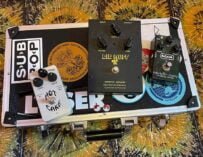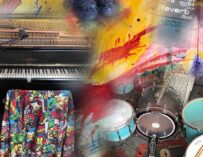
Round-up (left to right): Electro-Harmonix Nano Looper 360, TC-Helicon Ditto Mic Looper and Boss RC-1 Loop Station
Whether you’re layering sounds or creating a mini-symphony, loopers are a great songwriting tool. We check out three recent models
As a newcomer neither to the world of effects pedals nor to the world of home recording, it seemed odd that I’d never used a looping pedal. So when I was asked whether I’d like to try out some simple looping pedals for Songwriting, I jumped at the chance. Having recruited my bandmate and fellow songwriter James Lloyd, we set about testing pedals from three of the biggest names in the effects pedals business. Here’s how we got on.
First up on our voyage of discovery, we have the Electro-Harmonix Nano Looper 360 (RRP: £109) ready to pop our looping cherry.

Electro-Harmonix Nano Looper 360
The first thing you notice is the pedal’s size. It’s the smallest one we tested, and its compact size is great for portability and saving precious space on the pedalboard. First impressions are good: the pedal feels solid and has a robust, almost handcrafted feel to it.
Operating the pedal is simple. Once you get used to what the three blinking lights are telling you, and in what order to press the footswitch to record and overdub, the Nano Looper 360 becomes very easy to use, very quickly – ideal for a novice like me. The sound quality and reproduction is spot on too, with no loss of volume or audible hiss to speak of.
The best feature of this pedal, though, are the 11 selectable looping channels on offer. These allow you to store multiple loops in the pedal’s six-minute memory – extremely useful for jamming and writing. If you want to get more advanced, you could try chopping and changing between pre-recorded loops as you go along, though you’d have to bend down to turn the dial, which obviously isn’t ideal.
The only thing we found annoying about the EHX pedal was the difficulty in changing the battery, which involves removing four screws from the underside of the unit – not exactly convenient if you run out of juice during a performance. Luckily, the pedal does come with a power supply.
And if we were really nitpicking, we would point out that the footswitch isn’t that comfy to use if you aren’t wearing shoes. This can be quite important when playing in the comfort of your own home!
Next up, we sampled the delights of the Boss RC-1 Loop Station (RRP: £95).

Boss RC-1 Loop Station
You always know what you’re getting with a Boss pedal, and this one’s no exception: it’s a strong, solid unit and, as ever, it feels like you could built a house with them. It works in a similar way to the Nano Looper 360, but with the addition of a swish lighting system that tells you whereabouts you are in the loop.
This is a great-looking feature, but we found the system a little hit-and-miss, with some timing inconsistencies. For instance, it seems to keep rhythm with the loop as it plays back, until the last second when it sometimes speeds up and ends the loop when you’re least expecting it. However, the green and red lights are bright (handy for low-light conditions) and – dare we say it – quite sexy.
The major downside of the RC-1 is that its (admittedly impressive) 12 minutes of looping time are limited to just one channel – there’s no option to record on separate channels as with the Nano Looper 360. It’s unlikely you’re ever going to need the full 12 minutes of recording time, so this feels like a missed opportunity from Boss.
As a home recording tool or an introduction to the world of looping, the Boss pedal makes a lot of sense as a no-nonsense piece of kit. But with only one channel on offer, we’d recommend looking elsewhere if you need a more versatile pedal for songwriting and testing out new ideas.
Finally, we have the TC-Helicon Ditto Mic Looper (RRP: £129). Now, this isn’t really a fair comparison because it’s intended for looping vocals rather than guitars, but it could still prove useful for acoustic performances if you prefer to mic up your guitar. The sound reproduction is once again spot on, and the design of the pedal is top-notch.

TC-Helicon Ditto Mic Looper
With just two buttons (‘stop’ and ‘loop’) and one knob (‘loop level’), it’s extremely easy to use – we had it sussed within five minutes of getting it out of the box. The addition of a ‘stop’ button is a welcome addition – the guitar pedals required us to tap twice to stop the loop, which could be a bit fiddly.
We would like to have seen some built-in effects, such as reverb or delay, but this is obviously easily resolved if you’re using a PA system or other effects pedals. All in all, if you’re after a rudimentary looper for experimenting with your vocals in a live or studio setting, this is a great choice.
Once all our testing was over, we both agreed that the Electro-Harmonix Nano Looper 360 had to win the gold medal. Its uncomplicated nature and 11 memory channels just edge it ahead of the Boss pedal for us – it’d be a great addition to any home recording set-up. However, if you’re serious about loop-based performance, you might need to look at spending a bit more money on the next level up of looping pedal. These boast more options and versatility, allowing you to really build up your solo opus.
James Cutmore & James Lloyd




































Related Articles